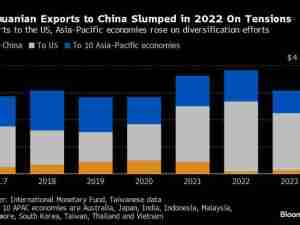China’s exports slumped in December as a rush of orders to beat expected tariffs showed signs of fading and as domestic buyers succumbed to a worsening economic outlook.
The worse than expected figures, with exports falling 4.4 percent in December from a year earlier, set a grim domestic backdrop for China’s negotiators as they seek a deal to end the stand-off with the Trump administration. The fall in exports was the worst result since 2016 in dollar terms while imports slumped 7.6 percent, also the worst reading since 2016 and hinting at softening demand at home.
At the same time, China’s overall trade surplus with the U.S. hit a record in 2018, underscoring the political imperative to cut a deal ahead of a March 1 deadline after which U.S. President Donald Trump has threatened to impose additional tariffs on Chinese goods.
The numbers show how the world’s biggest trading nation is being hit by a confluence of slowing global growth and by uncertainty linked to the trade war—factors that are expected to linger in the near term, at least.
“The bad trade data will quite likely increase the pressure on China to achieve a deal, or at least a suspension of the U.S. tariff hikes,” said Louis Kuijs, chief Asia economist at Oxford Economics in Hong Kong. “At the same time, the U.S. side also seems to be under more pressure to de-escalate tension in terms of news on the economy and financial markets than a few months ago.”
Chinese Vice Premier Liu He is slated to travel to the U.S. for further talks around the end of this month, with little progress seen so far on the tougher areas of the dispute such as China’s treatment of intellectual property or support for state firms. The headwinds from trade comes at a time when policy makers are already grappling with decelerating consumption, falling factory sentiment, fears of producer deflation and a worsening employment outlook.
Stocks fell with the Australian dollar after the data were released, with losses in Asian equities most pronounced in Hong Kong. Futures pointed to lower open for sessions in Europe and the U.S. amid signs January’s rally in risk assets is abating.
There’s more bad news to come, according to economists at Commerzbank AG and Australia & New Zealand Banking Group Ltd.
Chinese shipments are already under pressure from slowing demand from top trade partners—Europe’s recovery is under question, with Germany triggering recession fears, Japan is facing a tougher 2019 and the U.S. itself forecast to see waning growth after a robust 2018. China’s exports to the U.S., European Union, Hong Kong, Japan and Taiwan all fell from a year earlier. South Korea’s exports—often viewed as a bellwether for world trade—fell in December.
“There is a clear downward trend,” said Zhou Hao, an economist with Commerzbank in Singapore who was among the few to accurately forecast a December contraction in exports. “This is not just due to the trade war and tariffs. On top of those, the major drag is slowing global demand.”
While China is no longer as dependent on trade, as the world’s largest exporter, factory output, profits and employment still hinge on demand from overseas. Its domestic appetite also affects production by commodity and machinery exporters around the world. Stabilizing trade is one of the goals the leadership set for 2019, on top of supporting employment, investment and the finance sector.
Negotiators expressed optimism after mid-level talks wrapped in Beijing last week, bringing some temporary relief to global investors. Less certain are the further results, as Trump is trying to both appeal to the stock market with a deal, and get expanded tariff powers under a new draft law.
Few economists are betting on a grand deal that would dissolve the economic confrontations between China and the U.S. for good.
“Significant uncertainty remains as to whether there could be a ‘deal’ after March 1,” Citigroup Inc economists led by Liu Ligang wrote in a note. “We believe trade growth next year will slow significantly on huge uncertainty and a high base.”





